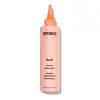What's inside
What's inside
 Key Ingredients
Key Ingredients

 Benefits
Benefits

 Concerns
Concerns

 Ingredients Side-by-side
Ingredients Side-by-side

Water
Skin ConditioningCetearyl Alcohol
EmollientBehentrimonium Chloride
PreservativeAmodimethicone
CI 77891
Cosmetic ColorantCI 17200
Cosmetic ColorantCI 19140
Cosmetic ColorantMica
Cosmetic ColorantHydroxycitronellal
PerfumingPhenoxyethanol
PreservativeTrideceth-6
EmulsifyingLimonene
PerfumingBenzoic Acid
MaskingLinalool
PerfumingIsopropyl Alcohol
SolventPotassium Hydroxide
BufferingCetrimonium Chloride
AntimicrobialHexyl Cinnamal
PerfumingGlycolic Acid
BufferingParfum
MaskingWater
Skin ConditioningGlycerin
HumectantHydrolyzed Linseed Seed
HumectantVitis Vinifera Leaf Extract
Skin ConditioningWine Extract
AntioxidantGlycine Soja Germ Extract
EmollientScutellaria Baicalensis Root Extract
AstringentHippophae Rhamnoides Fruit/Seed Oil
AntimicrobialTriticum Vulgare Germ Extract
Skin ConditioningGlycine
BufferingAlanine
MaskingArginine
MaskingAspartic Acid
MaskingHistidine
HumectantIsoleucine
Skin ConditioningPhenylalanine
MaskingProline
Skin ConditioningSerine
MaskingThreonine
Valine
MaskingLactic Acid
BufferingCetrimonium Chloride
AntimicrobialSodium PCA
HumectantSodium Lactate
BufferingPCA
HumectantCitric Acid
BufferingBenzophenone-4
UV AbsorberLactobacillus Ferment
Skin ConditioningCalcium Gluconate
HumectantPropylene Glycol
HumectantPolyquaternium-7
Polyquaternium-10
Cellulose
AbsorbentPolysorbate 20
EmulsifyingPropanediol
SolventSilicone Quaternium-8
Trideceth-10
CleansingHydroxyethylcellulose
Emulsion StabilisingEthylhexylglycerin
Skin ConditioningGluconolactone
Skin ConditioningSodium Acetate
BufferingPotassium Sorbate
PreservativeSodium Benzoate
MaskingBenzyl Alcohol
PerfumingPhenoxyethanol
PreservativeIsopropyl Alcohol
SolventParfum
MaskingHydroxycitronellal
PerfumingLimonene
PerfumingWater, Glycerin, Hydrolyzed Linseed Seed, Vitis Vinifera Leaf Extract, Wine Extract, Glycine Soja Germ Extract, Scutellaria Baicalensis Root Extract, Hippophae Rhamnoides Fruit/Seed Oil, Triticum Vulgare Germ Extract, Glycine, Alanine, Arginine, Aspartic Acid, Histidine, Isoleucine, Phenylalanine, Proline, Serine, Threonine, Valine, Lactic Acid, Cetrimonium Chloride, Sodium PCA, Sodium Lactate, PCA, Citric Acid, Benzophenone-4, Lactobacillus Ferment, Calcium Gluconate, Propylene Glycol, Polyquaternium-7, Polyquaternium-10, Cellulose, Polysorbate 20, Propanediol, Silicone Quaternium-8, Trideceth-10, Hydroxyethylcellulose, Ethylhexylglycerin, Gluconolactone, Sodium Acetate, Potassium Sorbate, Sodium Benzoate, Benzyl Alcohol, Phenoxyethanol, Isopropyl Alcohol, Parfum, Hydroxycitronellal, Limonene
 Reviews
Reviews

Ingredients Explained
These ingredients are found in both products.
Ingredients higher up in an ingredient list are typically present in a larger amount.
This ingredient is a preservative, antimicrobial, and emulsifier. It is often used in cosmetics for its ability to cleanse, condition, and reduce static.
Cetrimonium chloride is a quaternary ammonium salt, meaning it has a water-soluble structure.
Hydroxycitronellal is a fragrance created from citronellal. The smell of hydroxycitronellal is often described as "citrus-like" or "melon-like".
Hydroxycitronellal is a known EU allergen and may cause irritation when applied to the skin.
Isopropyl Alcohol is more commonly known as rubbing alcohol. It is most commonly used as a solvent, meaning it helps other ingredients dissolve.
This ingredient is an astringent alcohol. Astringent alcohols may also irritate skin as they high amounts may strip away your skin's natural oils.
Other types of astringent alcohols include:
According to the National Rosacea Society based in the US, you should be mindful of products with these alcohols in the top half of ingredients.
Any type of sanitizing product will have high amounts of alcohol to help kill bacteria and viruses.
Learn more about Isopropyl AlcoholLimonene is a fragrance that adds scent and taste to a formulation.
It's found in the peel oil of citrus fruits and other plants such as lavender and eucalyptus. The scent of limonene is generally described as "sweet citrus".
Limonene acts as an antioxidant, meaning it helps neutralize free radicals.
When exposed to air, oxidized limonene may sensitize the skin. Because of this, limonene is often avoided by people with sensitive skin.
The term 'fragrance' is not regulated in many countries. In many cases, it is up to the brand to define this term. For instance, many brands choose to label themselves as "fragrance-free" because they are not using synthetic fragrances. However, their products may still contain ingredients such as essential oils that are considered a fragrance.
Learn more about LimoneneParfum is a catch-all term for an ingredient or more that is used to give a scent to products.
Also called "fragrance", this ingredient can be a blend of hundreds of chemicals or plant oils. This means every product with "fragrance" or "parfum" in the ingredients list is a different mixture.
For instance, Habanolide is a proprietary trade name for a specific aroma chemical. When used as a fragrance ingredient in cosmetics, most aroma chemicals fall under the broad labeling category of “FRAGRANCE” or “PARFUM” according to EU and US regulations.
The term 'parfum' or 'fragrance' is not regulated in many countries. In many cases, it is up to the brand to define this term.
For instance, many brands choose to label themselves as "fragrance-free" because they are not using synthetic fragrances. However, their products may still contain ingredients such as essential oils that are considered a fragrance by INCI standards.
One example is Calendula flower extract. Calendula is an essential oil that still imparts a scent or 'fragrance'.
Depending on the blend, the ingredients in the mixture can cause allergies and sensitivities on the skin. Some ingredients that are known EU allergens include linalool and citronellol.
Parfum can also be used to mask or cover an unpleasant scent.
The bottom line is: not all fragrances/parfum/ingredients are created equally. If you are worried about fragrances, we recommend taking a closer look at an ingredient. And of course, we always recommend speaking with a professional.
Learn more about ParfumPhenoxyethanol is a preservative that has germicide, antimicrobial, and aromatic properties. Studies show that phenoxyethanol can prevent microbial growth. By itself, it has a scent that is similar to that of a rose.
It's often used in formulations along with Caprylyl Glycol to preserve the shelf life of products.
Water. It's the most common cosmetic ingredient of all. You'll usually see it at the top of ingredient lists, meaning that it makes up the largest part of the product.
So why is it so popular? Water most often acts as a solvent - this means that it helps dissolve other ingredients into the formulation.
You'll also recognize water as that liquid we all need to stay alive. If you see this, drink a glass of water. Stay hydrated!
Learn more about Water